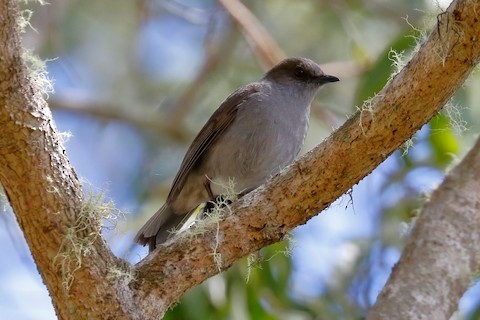Birdfinding.info ⇒ The Oma’o remains locally common across the eastern and southern highlands of the Big Island. Sites where it can usually be found include the kipukas along Saddle Road (especially on the Pu’u O’o Trail through Kipuka Ainahou), the restricted Pua Akala Tract in Hakalau Forest National Wildlife Refuge, and some of the trails in Hawaii Volcanoes National Park.
Oma’o
Myadestes obscurus
Endemic to the Big Island of Hawaii, where it occurs in native forests and scrub between about 700 and 3,000 m elevation.
Formerly distributed over most of the island down to 300 m, including the Kohala Mountains and Kona highlands, but by the mid-1900s it had retreated upslope and apparently vanished from the north and west.
It remained numerous in the east and south, from the northern slopes of Mauna Kea south through the kipukas and eastern forests, and west to the southwestern slopes of Mauna Loa. In the 1970s the total population was estimated at approximately 169,000, and it appears to have remained stable since then, with some local increases and recolonization of lower elevations.
Identification
A plump, short-tailed Myadestes solitaire with brown upperparts, a darker mask or eyestripe, and medium-gray underparts.

Oma’o. (Pu’u O’o Trail, Big Island, Hawaii; March 30, 2015.) © BB Oros
Typically shows pale, cream-colored undertail coverts.
Sometimes shows a rusty tinge at the base of the flight feathers.
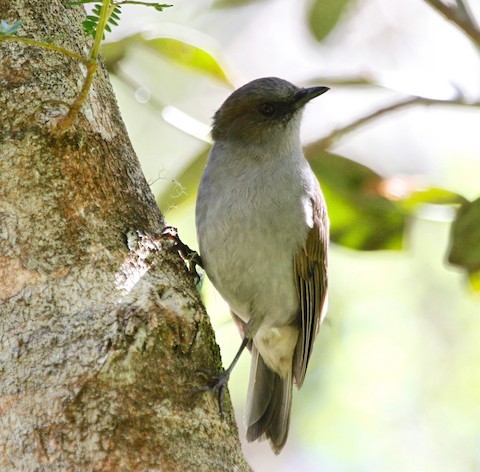
Oma’o. (Pu’u O’o Trail, Big Island, Hawaii; July 31, 2017.) © Sherman Wing
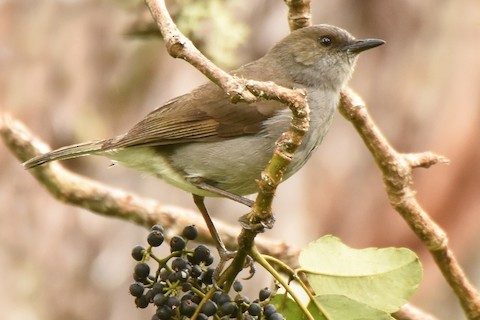
Oma’o. (Pua Akala Tract, Hakalau Forest National Wildlife Refuge, Big Island, Hawaii; August 4, 2015.) © Steven Mlodinow

Oma’o. (Pua Akala Tract, Hakalau Forest National Wildlife Refuge, Big Island, Hawaii; September 6, 2017.) © Kathryn Dia
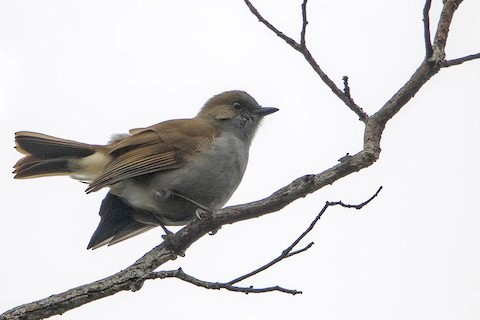
Oma’o. (Pu’u O’o Trail, Kipuka Ainahou, Big Island, Hawaii; September 15, 2018.) © Bradley Hacker
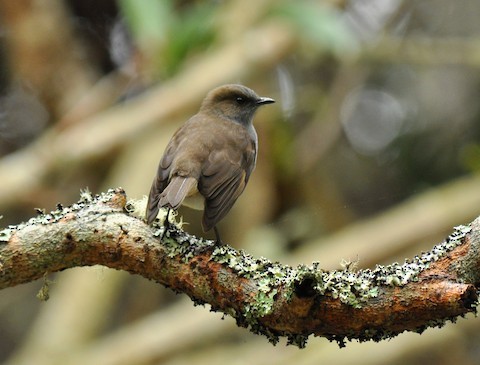
Oma’o. (Pu’u O’o Trail, Kipuka Ainahou, Big Island, Hawaii; November 4, 2011.) © Ryan O’Donnell

Oma’o. (Hakalau Forest National Wildlife Refuge, Big Island, Hawaii; August 11, 2018.) © Dubi Shapiro
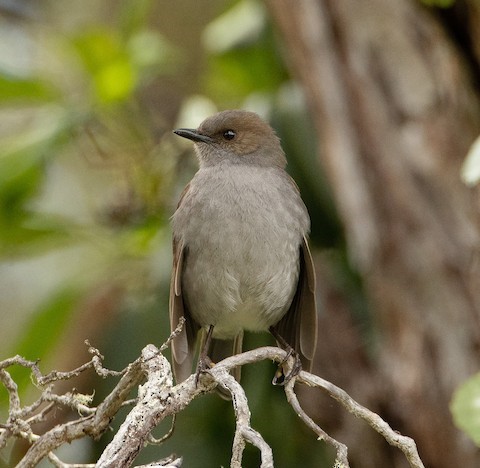
Oma’o. (Pua Akala Tract, Hakalau Forest National Wildlife Refuge, Big Island, Hawaii; April 16, 2019.) © Wolfe Repass

Oma’o. (Pu’u O’o Trail, Kipuka Ainahou, Big Island, Hawaii; March 25, 2017.) © Jason Van
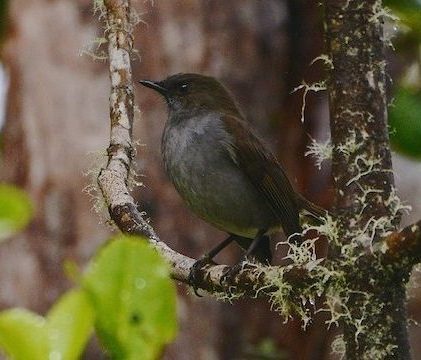
Oma’o. (Pua Akala Tract, Hakalau Forest National Wildlife Refuge, Big Island, Hawaii; November 28, 2015.) © Alan Van Norman

Oma’o. (Pua Akala Tract, Hakalau Forest National Wildlife Refuge, Big Island, Hawaii; August 4, 2015.) © Steven Mlodinow
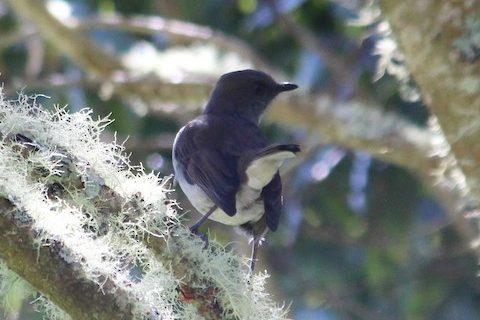
Oma’o. (Pua Akala Tract, Hakalau Forest National Wildlife Refuge, Big Island, Hawaii; September 23, 2018.) © Kathryn Hart
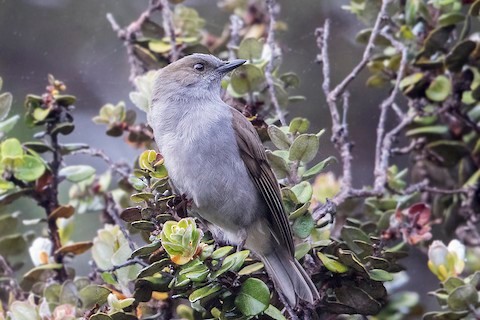
Oma’o. (Pu’u O’o Trail, Big Island, Hawaii; September 16, 2018.) © Bradley Hacker

Oma’o. (Hakalau Forest National Wildlife Refuge, Big Island, Hawaii; March 28, 2017.) © Jennifer Allison
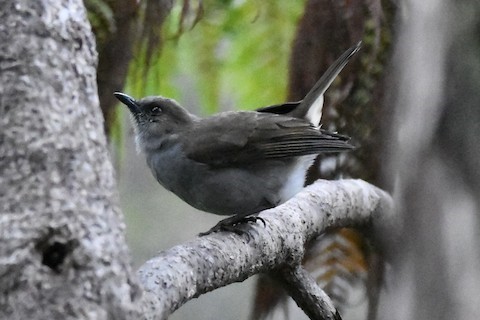
Oma’o. (Hawaii Volcanoes National Park, Big Island, Hawaii; February 11, 2017.) © Cathryn Dippo
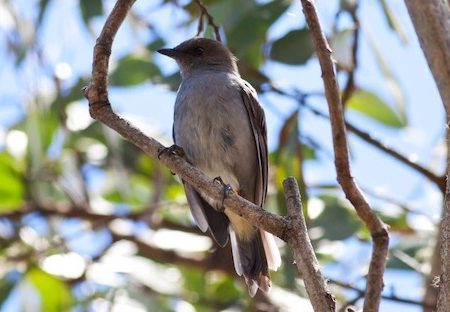
Oma’o. (Pu’u O’o Trail, Kipuka Ainahou, Big Island, Hawaii; July 17, 2013.) © Michael Todd
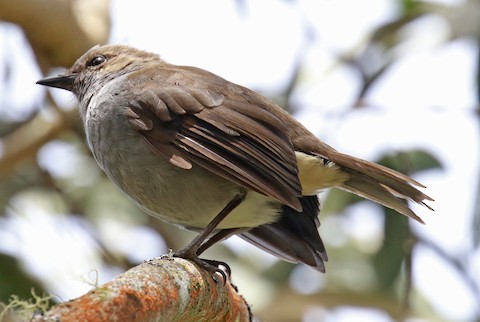
Oma’o. (Pu’u O’o Trail, Kipuka Ainahou, Big Island, Hawaii; July 20, 2018.) © Jordan Roderick
Immatures have dark-gray underparts with dense, pale spots.

Oma’o, immature. (Pua Akala Tract, Hakalau Forest National Wildlife Refuge, Big Island, Hawaii; August 9, 2017.) © Ruben Stoll

Oma’o, immature. (Pua Akala Tract, Hakalau Forest National Wildlife Refuge, Big Island, Hawaii; August 9, 2017.) © Victor Stoll
Notes
Monotypic species. Traditionally considered conspecific with the Kama’o (M. myadestinus), Amaui (M. woahensis), and Oloma’o (M. lanaiensis), collectively known as the Hawaiian Thrush (M. obscurus), but recognized as separate species since 1982. The other three are thought to be extinct.
IUCN Red List Status: Vulnerable.
References
BirdLife International. 2016. Myadestes obscurus. The IUCN Red List of Threatened Species 2016: e.T22708579A94165878. https://dx.doi.org/10.2305/IUCN.UK.2016-3.RLTS.T22708579A94165878.en. (Accessed July 24, 2020.)
Collar, N. 2020. Omao (Myadestes obscurus). In Handbook of the Birds of the World Alive (J. del Hoyo, A. Elliott, J. Sargatal, D.A. Christie, and E. de Juana, eds.). Lynx Edicions, Barcelona. https://www.hbw.com/node/58234. (Accessed May 10, 2020.)
eBird. 2020. eBird: An online database of bird distribution and abundance. Cornell Lab of Ornithology, Ithaca, N.Y. http://www.ebird.org. (Accessed July 24, 2020.)
Pratt, H.D., P.L. Bruner, and D.G. Berrett. 1987. A Field Guide to the Birds of Hawaii and the Tropical Pacific. Princeton University Press.
Pratt, H.D. 1993. Enjoying Birds in Hawaii: A Birdfinding Guide to the Fiftieth State (Second Edition). Mutual Publishing, Honolulu, Hawaii.
Pyle, R.L., and P. Pyle. 2017. The Birds of the Hawaiian Islands: Occurrence, History, Distribution, and Status. Version 2 (January 1, 2017). http://hbs.bishopmuseum.org/birds/rlp-monograph/. B.P. Bishop Museum, Honolulu, Hawaii.
Xeno-Canto. 2020. Omao – Myadestes obscurus. https://www.xeno-canto.org/species/Myadestes-obscurus. (Accessed July 24, 2020.)
